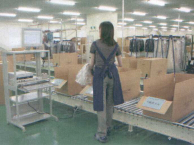July 10, 2003 – Leading Information Technology Institute, a privately held, for-profit Japanese company, aims to help Japan’s apparel industry leapfrog competitors through the use of RFID technologies. LITI says its Hyper Cart Picking System offers Japanese companies a way to radically improve their warehouse operations.
The Hyper Cart Picking System has a PC and RFID reader on it. Warehouse management software gives the operator instructions about what to pick and where it’s located via a wireless LAN connection. The RFID reader verifies the RFID tag on each item that is being put into a box for delivery and passes the information to the host system. Each box also has an RFID tag, which contains a list of all the items inside.
Most Japanese apparel companies are still managing this process with pen and paper, so the productivity improvement is dramatic, according to LITI spokesman Shumpei Mumakami. “Our system allows for easy product location inside the warehouse along with simultaneous inspection/identification of the product,” he says. “The system also has the added plus of being quick and easy to learn and use.”
LITI is primarily focused on the Japanese apparel industry because RFID makes the most sense on high-value items. “Clothing is still quite expensive in Japan, so the added cost of RFID tags and readers are a minor component of the total item cost,” says Mark Hathaway, president of LITI USA, a division started two years ago to obtain patents for LITI’s technology in the United States.
“Last year, we had about 10 customers in Japan,” says Hathaway. “They cover the entire range of the distribution chain.”
About 75 percent of LITI’s $22 million in sales last year were for systems and installation/training services. The other 25 percent came from a contract distribution center that it set up, using its own RFID technology. The DC not only contributes to revenue, but also serves as a marketing tool, since potential customers can see how the picking system increases productivity.
The LITI picking system uses both 125 KHz and 13.56 MHz tags and readers. It sources the RFID system components primarily from Nippon Avionics and from Mitsubishi Materials Corp.
LITI declined to disclose pricing, but said that over time, improved efficiency, fewer faulty orders being sent and returned and other “soft savings” should more than pay for the equipment costs. The company plans to expand beyond apparel to the shoe and restaurant industries, says Murakami. — By Mark Carroll


